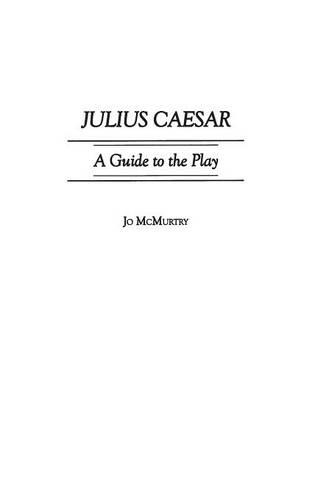
Julius Caesar: A Guide to the Play
(Hardback)
Publishing Details
Julius Caesar: A Guide to the Play
By (Author) Josephine McMurtry
Bloomsbury Publishing PLC
Greenwood Press
28th October 1998
United States
Classifications
Tertiary Education
Non Fiction
Literary studies: c 1600 to c 1800
822.33
Physical Properties
Hardback
160
Description
Perhaps more than any other single work, Shakespeare's Julius Caesar has popularized the image of Brutus as a ruthless and cowardly traitor, Caesar as a noble ruler and sympathetic victim, and the Ides of March as a time of danger and duplicity. On the surface, the play is comparatively simple and straightforward, and thus it has served to introduce generations of students to Shakespeare's works. But the play is deceptive in its apparent simplicity. While Brutus joins the conspirators in assassinating Caesar, his possibly selfless motives may make him the noblest Roman of them all. And while Caesar emerges as a beneficent leader in Antony's funeral oration, other traditions with which Shakespeare's audience would have been familiar paint him as a tyrannical despot. The play, then, is laden with ambiguity, and it raises more questions about human nature than it answers about Roman history. And while some scholars have criticized the play's language for being relatively unpoetic and inferior to some of Shakespeare's later tragedies, Julius Caesar has given us some of the most memorable passages in English literature. This addition to the Greenwood Guides to Shakespeare series offers a comprehensive overview of Julius Caesar and the issues central to an understanding and appreciation of the tragedy. Written at a level accessible to readers of all backgrounds, from secondary school students to scholars, the volume gives full attention to textual, contextual, dramatic, thematic, critical, and performance aspects of the play. The book begins with a look at the history of the text and a consideration of some modern editions. It then examines the historical and cultural contexts of Shakespeare's England and shows how they shaped his work. The book discusses Shakespeare's likely sources and how he adapted them, and it analyzes his dramatic art, including his characterizations, language, and imagery. The guide then turns to the themes treated throughout the play, and it surveys the tragedy's critical reception. Finally, the book charts the drama's lengthy stage history and looks closely at representative productions, including some film versions. An annotated bibliography and comprehensive index conclude the work.
Reviews
Both teacher and student will find this an instructive and enlightening guide. If Shakespeare's Julius Caesar is part of the school curriculum, this book should be on the library shelves.-The Book Report
Well-written and researched, without being pedantic, and constructed to be read without regard to order of presentation, this slim reference book is remarkable for its coverage-including sections on textual history, contexts and sources, dramatic structure, themes, critical approaches, and the play in performance. An important addition to Shakespeare studies, this work is a must-have for high school, public, and academic libraries.-VOYA
"Both teacher and student will find this an instructive and enlightening guide. If Shakespeare's Julius Caesar is part of the school curriculum, this book should be on the library shelves."-The Book Report
"Well-written and researched, without being pedantic, and constructed to be read without regard to order of presentation, this slim reference book is remarkable for its coverage-including sections on textual history, contexts and sources, dramatic structure, themes, critical approaches, and the play in performance. An important addition to Shakespeare studies, this work is a must-have for high school, public, and academic libraries."-VOYA
Author Bio
JO MCMURTRY is Professor of English at the University of Richmond. She has published widely on Shakespeare, and her most recent books include Shakespeare Films in the Classroom: A Descriptive Guide (1994), and Understanding Shakespeare's England: A Companion for the American Reader (1989).
